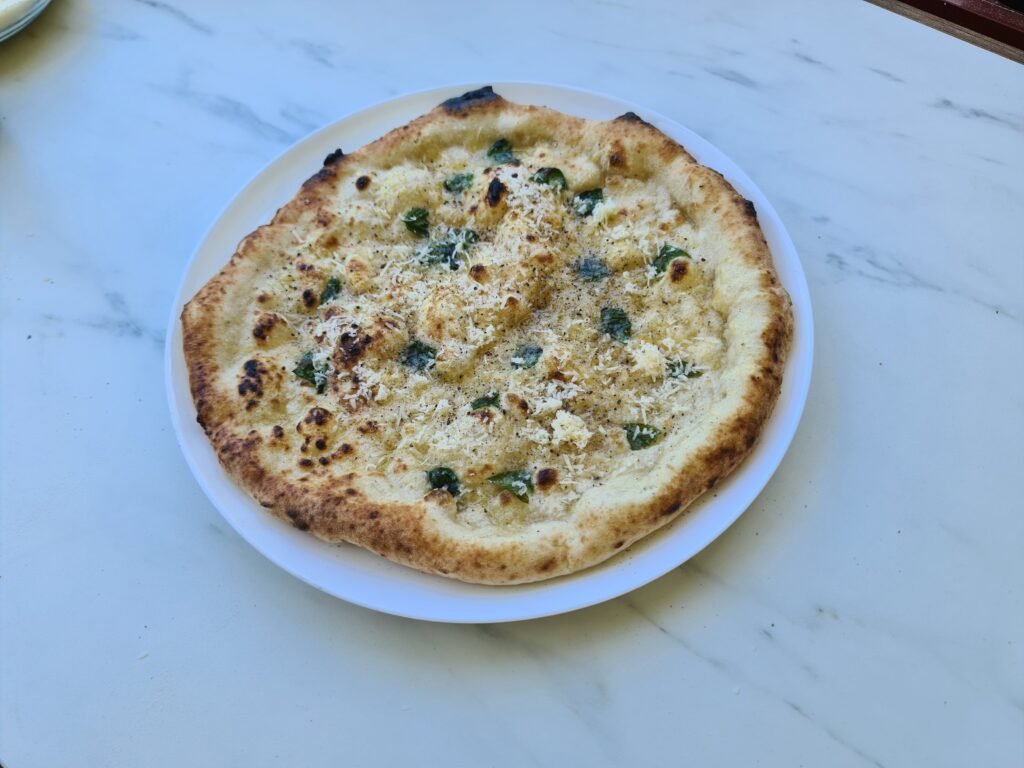You’ve probably heard of Margherita and Marinara when it comes to Neapolitan pizzas, but what about their older cousin, Pizza Mastunicola?
This is where it all started, the oldest named pizza from Naples, dating back to around 1600. In this post, we will dive into the story of Pizza Mastunicola. We will explore its ingredients, and how you can bring a piece of Neapolitan history to your table.
What is Mastunicola?
Most people think of flavorful tomatoes and creamy mozzarella when they hear about Neapolitan pizza. But there’s more to the story.
Pizza Mastunicola is the oldest known Neapolitan pizza. Topped with lard, fresh basil leaves, sharp hard cheese, and black pepper, the Mastunicola offers a taste of tradition.

The first time I tried this classic, I didn’t expect much. But it has since become one of my favorite pizzas. The combination of rich lard, aromatic herbs, and tangy cheese creates a uniquely satisfying experience.
History of the Neapolitan Pizza Mastunicola
The origins of the Mastunicola stretch back to a time before tomatoes became synonymous with pizza in Italy.
The use of the word “pizza” in its current form, and the concept of enriching flatbread with various toppings, is recorded from the 1600s in Southern Italy. Back then, pizzas were made more flavorful than traditional flatbreads by adding ingredients like lard and garlic.
The history is not extensively documented. Some sources indicate that farmers’ wives used to prepare discs of bread enriched with lard, slices of cheese, and other ingredients to feed their husbands working in the fields.
A study by Giacomo Orlando, preserved by the University of Udine, reveals that “mastunicola” referred to a richer pizza variation made with soft dough during the 16th and 17th centuries. This particular pizza was prepared with lard, goat cheese, basil, and pepper, offering a glimpse into the culinary practices of the time.
The Naming Debate
Culinary historians are divided over the origins of the name “Mastunicola.”
One theory suggests it traces back to “Master Nicola,” a famed baker in Naples renowned for his exceptional pies. Another theory links the name to the Neapolitan term for basil, “vasinicola.”
A Culinary Relic in Modern Times
The Mastunicola pizza has played an important role in the history of pizza. While it has been overshadowed by the famous Margherita named after the queen.
The recent resurgence of interest in authentic pizza traditions has not only led to a revival for Mastunicola but has also fostered a deeper appreciation for the roots of Neapolitan cuisine. Today, it’s once again appearing on the menus of Neapolitan pizzerias, offering both locals and visitors a slice of history.
This ancient pizza has also secured its place in pizza competitions. It’s recognized as its own category in the Vera Pizza Napoletana Olympic Games.
The Associazione Verace Pizza Napoletana (AVPN) has included Mastunicola in its international regulations, ensuring that this foundational element of Neapolitan pizza is celebrated and preserved for future generations.
How to make Pizza Mastunicola
Start with your favorite Neapolitan pizza dough. You can find my go-to recipe here.
Toppings
- 1 tablespoon of lard
- A handful of Pecorino Romano
- 3-5 large leaves of basil
- A few cranks of freshly ground black pepper
Steps
- Prepare the pizza base: Aim for a thin center with a puffed-up edge, known as the “cornicione,” to achieve that authentic Neapolitan pizza.
- Spread the Lard: With the base ready, gently spread a thin layer of lard over it.
- Add Basil: Scatter fresh leaves over the lard. This will infuse the pizza with an aromatic flavor during baking.
- Sprinkle Pecorino cheese: Generously sprinkle freshly grated pecorino cheese over the base. Pecorino adds a sharp, salty dimension that perfectly complements the richness of the lard.
- Season with pepper: Finish by giving the pizza a few cranks of fresh ground pepper to add a subtle heat that elevates the flavors of the pizza.
- Bake: Bake in a preheated oven at the highest temperature possible until the crust is golden and the cheese has melted to perfection.
Tip: For an extra burst of flavor, sprinkle a little extra pecorino and a few additional twists of black pepper over the pizza right after it comes out of the oven. This last touch adds a fresh layer of taste and aroma that makes all the difference.
- Is Your Pizza Dough Too Dry? Here is How to fix it! - June 10, 2024
- The Ultimate Guide to the Pizza Dough Windowpane Test - June 8, 2024
- The Ultimate Guide to Autolyse Pizza Dough - June 7, 2024